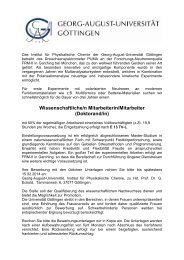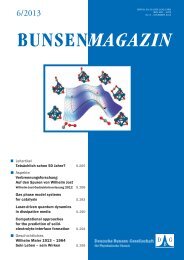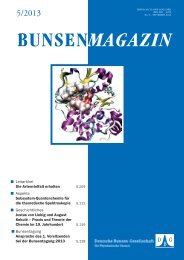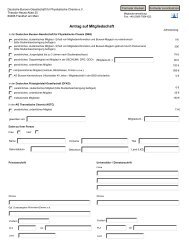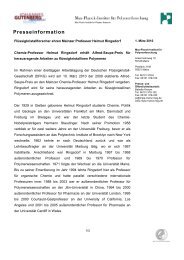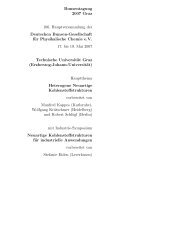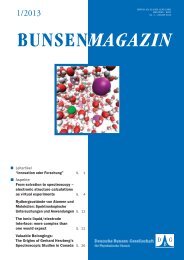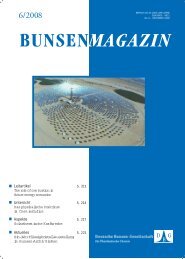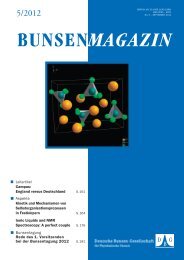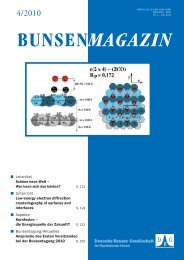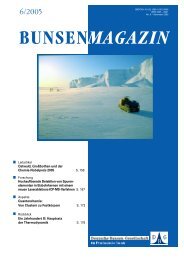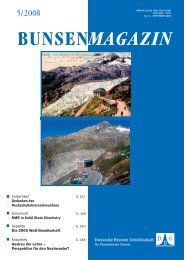BuMa_2005_05 - Deutsche Bunsengesellschaft für Physikalische ...
BuMa_2005_05 - Deutsche Bunsengesellschaft für Physikalische ...
BuMa_2005_05 - Deutsche Bunsengesellschaft für Physikalische ...
Erfolgreiche ePaper selbst erstellen
Machen Sie aus Ihren PDF Publikationen ein blätterbares Flipbook mit unserer einzigartigen Google optimierten e-Paper Software.
DEUTSCHE BUNSEN-GESELLSCHAFT<br />
Lehmann's polarizing microscope<br />
Lehmann immediately launched a systematic study, first of cholesteryl<br />
benzoate, and then of related compounds which exhibited the<br />
double-melting phenomenon. With his microscope, he was not only<br />
able to make observations in polarised light, but also, and this was a<br />
key advantage, his microscope possessed a hot stage enabling in situ<br />
high temperature observations. The intermediate cloudy phase clearly<br />
sustained flow, but other features, particularly the signature under a<br />
microscope, convinced Lehmann that he was dealing with a solid.<br />
By the end of August 1889 he had his own article ready for submission<br />
to the Zeitschrift <strong>für</strong> <strong>Physikalische</strong> Chemie [2] . The tone of this article,<br />
whose first paragraph will be of some interest to readers, not only<br />
isolated the key problem, but also gives some idea of the nature of<br />
Lehmann's personality.<br />
A S P E K T E<br />
The flowery and somewhat pompous language was to remain a characteristic<br />
both of Lehmann's scientific and of his more popular works.<br />
He found that the cloudiness of the intermediate fluid occurred when<br />
what we would now call nucleating droplets merge, and that sometimes<br />
the individual droplets exhibited a black cross when viewed between<br />
crossed nicols. The cloudiness itself was the macroscopic manifestation<br />
of 'large star-like radial aggregates of needles'.<br />
Lehmann was certain that the cloudy liquid possessed simultaneously<br />
liquid and crystal attributes, and believed truly to have discovered<br />
'crystals that flow'. Much of the rest of the article is concerned with<br />
advocating the coexistence of liquidity and crystallinity in the same<br />
material, and is not without rhetorical flashes. He must clearly have<br />
expected to meet with significant opposition.<br />
In a series of papers over the period 1890-1900 [3] , Lehmann made<br />
exhaustive studies of the phenomenon. Because the essence of the<br />
phenomenon seemed to occur in droplets, he made a virtue out of<br />
necessity and often deliberately prepared fluid mixtures from which<br />
the intermediate phase would then precipitate in droplet form. The<br />
coloured photographs of droplets in Fig 3. (and reproduced on the front<br />
page of this issue of the Bunsen Magazine) are taken from Lehmann's<br />
review article published in 1900.<br />
Lehmann's photographs of liquid crystal droplets. These dramatic pictures, originally<br />
taken only in black and white, were coloured by hand so as to resemble what he<br />
saw under the microscope.<br />
Lehmann found materials some of which exhibited, as in cholesteryl<br />
benzoate, two melting points, and some of which even exhibited<br />
three melting points. He found a phase which he called Fliessende<br />
Kristalle (flowing crystals) or Schleimig flüssige Kristalle (slimy liquid<br />
crystals), and another which he named Kristalline Flüssigkeit (crystalline<br />
fluid) or Tropfbar flüssige Kristalle (liquid crystals which form drops). If<br />
both phases existed in the same material the latter was always the<br />
higher temperature phase.<br />
The latter was cloudy, but the former was clear, although very viscous.<br />
All this culminated in a generously-sized 260 page tome [4], including<br />
no less than 483 illustrations drawn from his microscopic observations,<br />
published by Wilhelm Engelmann in Leipzig in 1904.<br />
His observations were quick to attract the attention of colleagues. As<br />
early as 1890, the organic chemist Ludwig Gattermann (1860-1920),<br />
at that time a Dozent from the University of Heidelberg and later to<br />
123



